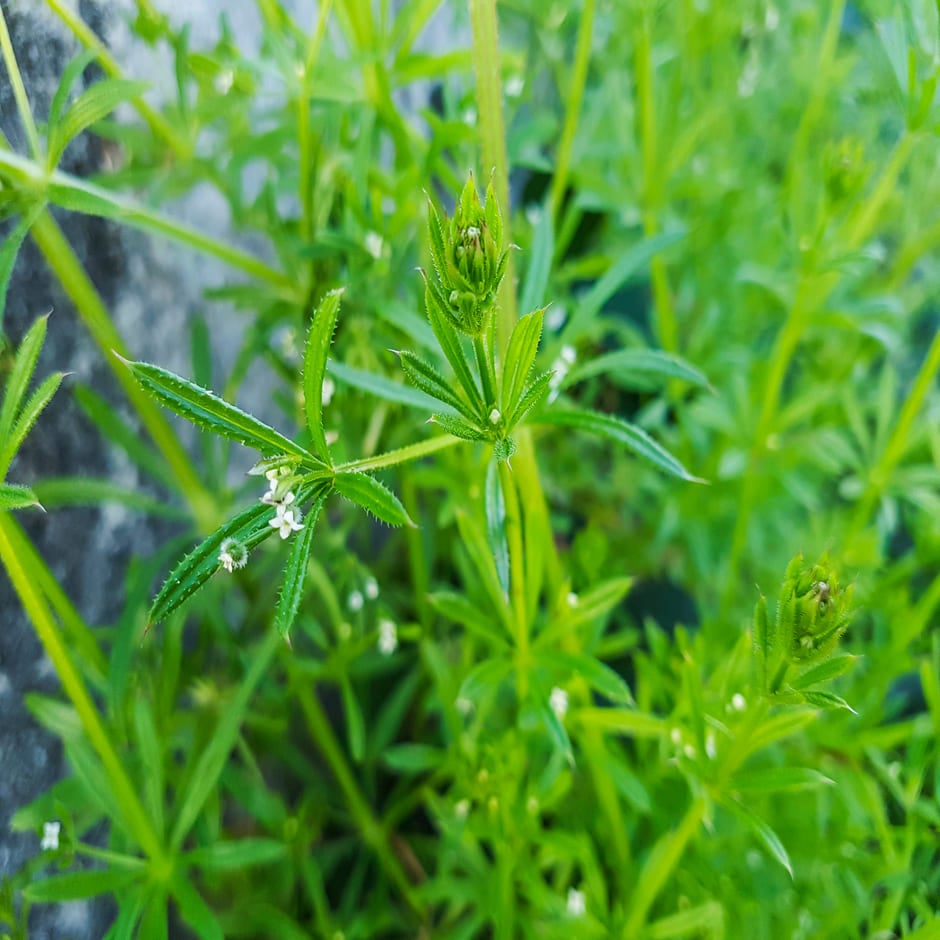Cleavers
Known for its characteristic Velcro-like stems, cleavers is an annual wildflower native to the UK. Its equally ‘sticky’ seeds are easily brought into gardens and the resultant plants can be a nuisance in garden beds. Here we help you decide whether to keep or remove it from your garden.

Quick facts
- Cleavers’ botanical name is Galium aparine
- It is also known as goosegrass and sticky willie
- Plants often find their way into gardens as seed attached to clothing or pet fur
- If you need to control cleavers, non-chemical methods are easy and effective
Jump to
What does cleavers look like?
Cleavers produces bright green, climbing or sprawling stems up to 1m (3¼ft) long. These bear whorls of slender green leaves and clusters of tiny, white, four-petalled flowers from May to August. Flowers quickly develop into small, round, green or purple fruits, and like the stems and leaves, these are covered in hooked bristles that help them attach to animals and passers-by.
Although cleavers aren’t easily confused with other weeds, its
Is cleavers a weed?
In gardens, cleavers is often more of a nuisance than a troublesome weed, with its sticky stems and seeds getting stuck to gardening gloves and clothing. However, as each plant can produce hundreds of seeds, and these are easily spread, cleavers can move into garden beds and may smother plants if allowed to establish.
Bear in mind that cleavers provides food for the caterpillars of many butterfly and moth species, including the barred straw moth and hummingbird hawk-moth, so is a valuable wildlife plant.
Frequently asked questions about controlling cleavers
Here are our answers to your most common questions about dealing with cleavers:
How invasive is cleavers?
Cleavers usually appears in gardens as individual plants, and as these are shallow-rooted, they are easily removed. However, cleavers is often not noticed until it is large enough to be scrambling into other plants or sprawling out into a bed, at which point it will likely already have set seed – so a single plant can quickly become a patch of cleavers seedlings.
Gardens that border farm or wasteland often have a more persistent problem with cleavers creeping in through boundary hedges, and need more regular weeding to prevent it taking over.
Do I need to get rid of cleavers?
No – allowing cleavers to grow in some areas, such as a wildlife corner or at the base of a mature hedge, is a great way to attract wildlife and increase the biodiversity of your garden.It is, however, a good idea to control the spread of cleavers, particularly around seedlings and young plants which could become smothered or suffer from competition.
What is the easiest way to kill cleavers?
If you have cleavers growing where it is not wanted, there are a few easy ways to remove it: - Pull or fork out plants – pinch out seedlings regularly, before they have chance to set seed. Mature plants can generally be removed in one pull if you identify the main stem. Alternatively, use a hand fork to lift plants out whole by their roots. Target where the roots are to limit soil disturbance. Add seedlings to a home compost bin, but consign mature weeds to your council green waste recycling bin instead.
- Hoe off plants – carefully hoe beds and borders to remove cleavers seedlings before they begin flowering and setting seed. Hoeing removes weeds with minimal soil disturbance. Do this on a dry, sunny day, so any uprooted plants shrivel and die rather than re-rooting.
- Smother plants – if you get many cleavers appearing in your garden, apply a mulch to your soil in early spring to smother new seedlings and prevent further seed germinating. Use bulky organic matter, such as bark chips, and apply a thick layer around 8cm (3in) deep for best effect. Another option is to fill gaps in borders with mat-forming ground cover plants.
Should I use a weedkiller?
As cleavers is easy to remove by hand-weeding and hoeing, there is no need to use a weedkiller to remove it from your garden.For more information, see our page on Weeds: non-chemical controls.
Get involved
The Royal Horticultural Society is the UK’s leading gardening charity. We aim to enrich everyone’s life through plants, and make the UK a greener and more beautiful place.